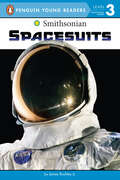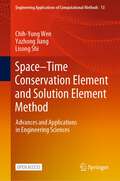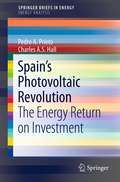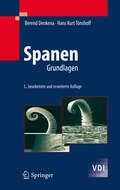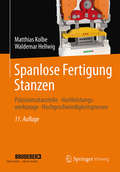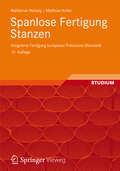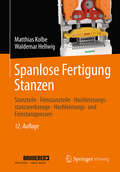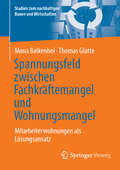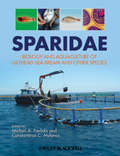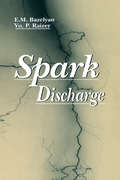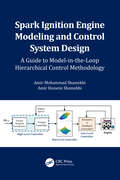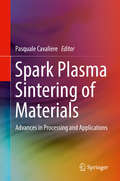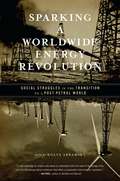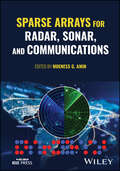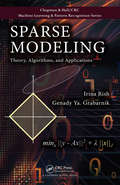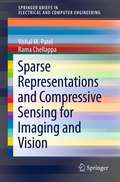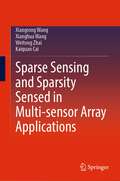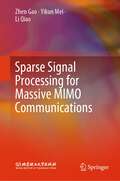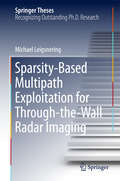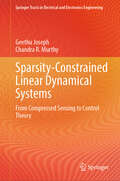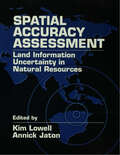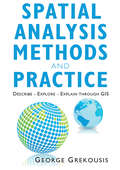- Table View
- List View
Spacesuits (Smithsonian)
by James BuckleyWhat does an astronaut wear to work? Find out in this space-age Penguin-Smithsonian reader!If you're going to orbit the Earth, moonwalk, or float in space, you need the right outfit. From helmet to space boots, every part of an astronaut's spacesuit is designed for survival. This reader, developed with Smithsonian's popular Air and Space Museum, provides a close look at the suits, boots, helmets, gloves, and other gear astronauts have worn into space, from the early days of space exploration to the present-day.
Space–Time Conservation Element and Solution Element Method: Advances and Applications in Engineering Sciences (Engineering Applications of Computational Methods #13)
by Chih-Yung Wen Yazhong Jiang Lisong ShiThis open access book introduces the fundamentals of the space–time conservation element and solution element (CESE) method, which is a novel numerical approach for solving equations of physical conservation laws. It highlights the recent progress to establish various improved CESE schemes and its engineering applications. With attractive accuracy, efficiency, and robustness, the CESE method is particularly suitable for solving time-dependent nonlinear hyperbolic systems involving dynamical evolutions of waves and discontinuities. Therefore, it has been applied to a wide spectrum of problems, e.g., aerodynamics, aeroacoustics, magnetohydrodynamics, multi-material flows, and detonations. This book contains algorithm analysis, numerical examples, as well as demonstration codes. This book is intended for graduate students and researchers who are interested in the fields such as computational fluid dynamics (CFD), mechanical engineering, and numerical computation.
Spain’s Photovoltaic Revolution: The Energy Return on Investment
by Charles A. Hall Pedro A. PrietoThe Energy Return on Energy Invested (EROI or EROEI) is the amount of energy acquired from a particular energy source divided by the energy expended, or invested, in obtaining that energy. EROI is an essential and seemingly simple measure of the usable energy or "energy profit" from the exploitation of an energy source, but it is not so easy to determine all of the energy expenditures that should be included in the calculation. Because EROI values are generally low for renewable energy sources, differences in these estimates can lead to sharply divergent conclusions about the viability of these energy technologies. This book presents the first complete energy analysis of a large-scale, real-world deployment of photovoltaic (PV) collection systems representing 3.5 GW of installed, grid-connected solar plants in Spain. The analysis includes all of the factors that limit and adjust the real electricity output through one full-year cycle, and all of the fossil fuel inputs required to achieve these results. The authors' comprehensive analysis of energy inputs, which assigns energy cost estimates to all financial expenditures, yields EROI values that are less than half of those claimed by other investigators and by the solar industry. Sensitivity analysis is used to test various assumptions in deriving these EROI estimates. The results imply that the EROI of current, large-scale PV systems may be too low to seamlessly support an energy and economic transition away from fossil fuels. Given the pervasiveness of fossil fuel subsidies in the modern economy, a key conclusion is that all components of the system that brings solar power to the consumer, from manufacturing to product maintenance and life cycle, must be improved in terms of energy efficiency. The materials science of solar conversion efficiency is only one such component. Sunny Spain represented an ideal case study as the country had the highest penetration of solar PV energy at 2.3 percent of total national demand as well as state-of-the-art expertise in solar power including grid management of intermittent, modern renewable systems. This book, written by a uniquely qualified author team consisting of the chief engineer for several major photovoltaic projects in Spain and the world's leading expert on the concept and application of EROI, provides a comprehensive understanding of the net energy available to society from energy sources in general and from functioning PV installations under real-world conditions in particular. The authors provide critical insight into the capacity of renewable energy sources to fill the foreseeable gap between world energy demand and depletion rates for fossil fuels. · Presents the first comprehensive study of the EROI of large-scale solar PV systems in a developed country · Uses real-world operational data rather than laboratory approximations and extrapolations · Describes the dependence of one alternative energy source on the goods and services of a fossil-fueled economy · Has global implications for the potential of renewable energy sources to replace dwindling reserves of fossil fuels · Written with the first-hand knowledge of the chief, on-site engineer for many solar installations in Spain together with the leader in the development and application of the concept of EROI
Spanen
by Berend Denkena Hans Kurt ToenshoffIn dem Band werden die physikalischen Grundlagen des Spanens unter Berücksichtigung neuester Forschungserkenntnisse dargestellt. Damit verknüpft stellen die Autoren wichtige Anwendungen wie z. B. Hochgeschwindigkeits- und Hochleistungsspanen vor. Sie vermitteln in dem Band die Anforderungen, denen moderne Werkzeuge und Werkzeugmaschinen sowie innovative Planungen spanender Prozesse genügen müssen. Die Möglichkeiten der Modellierung und Simulation werden in der 3. Auflage in einem neuen Kapitel erläutert. Mit Beispielaufgaben und Lösungen.
Spanlose Fertigung Stanzen
by Matthias Kolbe Waldemar HellwigDas vorliegende Lehr- und Fachbuch behandelt praxisorientiert die konventionelle Stanztechnik, die Hochleistungsstanztechnik und die Feinstanztechnik. Die Berechnungs- und Konstruktionsgrundlagen für das Schneiden, Biegen und Ziehen werden detailliert erklärt. Daneben gibt es wertvolle Hinweise für die Konstruktion von Werkzeugen und die Auswahl von Pressen.
Spanlose Fertigung Stanzen: Integrierte Fertigung komplexer Präzisions-Stanzteile
by Matthias Kolbe Waldemar HellwigDas vorliegende Lehr- und Fachbuch behandelt praxisorientiert die konventionelle Stanztechnik, die Hochleistungsstanztechnik und die Feinstanztechnik. Die Berechnungs- und Konstruktionsgrundlagen für das Schneiden, Biegen und Ziehen werden detailliert erklärt. Daneben gibt es wertvolle Hinweise für die Konstruktion von Werkzeugen und die Auswahl von Pressen.
Spanlose Fertigung Stanzen: Präzisionsstanzteile, Hochleistungswerkzeuge, Hochgeschwindigkeitspressen (Viewegs Fachbücher Der Technik Ser.)
by Matthias Kolbe Waldemar HellwigIn diesem Lehr- und Fachbuch finden Sie den aktuellen Stand der Stanz- und Feinstanztechnik. Gestaltungsregeln und Kennwerte aus der Praxis geben Hilfestellung bei der Konstruktion von Werkzeugen. Die rechnerische Bestimmung der Einflussgrößen, werkstofftechnische Grundlagen und funktionale Zusammenhänge unterstützen bei der Auswahl von Maschinen. Durch die zahlreichen Berechnungsbeispiele und vollständigen Lösungswege eignet sich dieses Buch sehr gut für das Selbststudium. In der 12. Auflage wurden Aktualisierungen und Neugestaltungen bei verbesserter Übersichtlichkeit vorgenommen. Neue Entwicklungen bei den Vorschubapparaten an Hochleistungsstanzautomaten sowie grundsätzliche Hinweise und Beispiele für die Hard- und Software zur Steuerung von Stanzprozessen wurden einbezogen. Völlig neu ist ein Kapitel, das alternative Schneidverfahren zur Erzielung hoher Schnittflächenqualitäten darstellt und einen direkten Vergleich zwischen einhubigen Schneidverfahren gestattet.
Spannungsfeld zwischen Fachkräftemangel und Wohnungsmangel: Mitarbeiterwohnungen als Lösungsansatz (Studien zum nachhaltigen Bauen und Wirtschaften)
by Thomas Glatte Mona BalkenholVor dem Hintergrund des aktuell herrschenden Wohnungsmangels und dem Mangel an Fachkräften in Deutschland werden Mitarbeiterwohnungen wieder neu entdeckt. Diese Publikation untersucht die Mitarbeiterwohnungen als passenden Lösungsansatz in dem Spannungsfeld zwischen Fachkräftemangel und Wohnungsmangel. Hierbei werden erste Einblicke in die Wahrnehmung von Akademikern der Generation Z in Bezug auf Mitarbeiterwohnungen gewährt. Ebenso stellt die Publikation Erkenntnisse für eine Steigerung der Arbeitgeberattraktivität gegenüber jungen Arbeitnehmern dar.
Sparidae: Biology and Aquaculture of Gilthead Sea Bream and Other Species
by Michalis Pavlidis Constantinos MylonasThe Sparidae, commonly known as breams and porgies, is a family of fishes of the order Perciformes, and includes about 115 species of mainly marine coastal fish of high economic value, exploited and farmed for human consumption, as well as for recreational purposes. This landmark publication brings together a huge wealth of information on the biology and culture of gilthead sea bream and other Sparidae species. Commencing with an overview of the current status of aquaculture of Sparidae, the book continues with comprehensive coverage of the family’s phylogeny, evolution and taxonomy, stress and welfare issues, and reproduction and broodstock management. Further chapters include coverage of early development and metabolism, production systems, nutrition, quality, and health management. A final cutting-edge chapter looks at genomic-proteomic research in Sparidae and its application to genetic improvement. With contributions from Europe, the Middle East, Asia, Australasia and North America, carefully drawn together and edited by Professor M. Pavlidis and Dr C. C. Mylonas, themselves well known for their work in this area, Sparidae is an essential purchase for anyone working with this important family of fishes. Fish biologists, fish farmers, aquaculture researchers, and fisheries managers will all find much of great use and interest within this book’s covers. All universities and research establishments where biological sciences, aquaculture and fisheries science are studied and taught should have copies of this excellent book on their shelves.
Spark Discharge
by YuriP. RaizerSpark Discharge is a first-of-its-kind text, providing a comprehensive and systematic description of the spark breakdown of long gas gaps. It discusses the nature of a long spark, physical peculiarities of relevant gas discharge processes, methods and results of experimental studies, and analytical and numerical models. The most important applications in high-voltage engineering are covered in a single volume. The straightforward presentation of complicated materials, the deep insight into the nature of the processes, and the simplified mathematical descriptions of the phenomena, make Spark Discharge an excellent textbook for students and an indispensable reference for researchers, physicists, and engineers.
Spark Ignition Engine Modeling and Control System Design: A Guide to Model-in-the-Loop Hierarchical Control Methodology
by Amir-Mohammad Shamekhi Amir Hossein ShamekhiThis book presents a step-by-step guide to the engine control system design, providing case studies and a thorough analysis of the modeling process using machine learning, and model predictive control (MPC). Covering advanced processes alongside the theoretical foundation, MPC enables engineers to improve performance in both hybrid and non-hybrid vehicles. Control system improvement is one of the major priorities for engineers seeking to enhance an engine. Often possible on a low budget, substantial improvements can be made by applying cutting-edge methods, such as artificial intelligence when modeling engine control system designs and using MPC. This book presents approaches to control system improvement at mid, low, and high levels of control. Beginning with the model-in-the-loop hierarchical control design of ported fuel injection SI engines, this book focuses on optimal control of both transient and steady state and also discusses hardware-in-the-loop. The chapter on low-level control discusses adaptive MPC and adaptive variable functioning, as well as designing a fuel injection feed-forward controller. At mid-level control, engine calibration maps are discussed, with consideration of constraints such as limits on pollutant emissions. Finally, the high-level control methodology is discussed in detail in relation to transient torque control of SI engines. This comprehensive yet clear guide to control system improvement is an essential read for any engineer working in automotive engineering and engine control system design.
Spark Plasma Sintering of Materials: Advances in Processing and Applications
by Pasquale CavaliereThis book describes spark plasma sintering (SPS) in depth. It addresses fundamentals and material-specific considerations, techniques, and applications across a broad spectrum of materials. The book highlights methods used to consolidate metallic or ceramic particles in very short times. It highlights the production of complex alloys and metal matrix composites with enhanced mechanical and wear properties. Emphasis is placed on the speed of the sintering processes, uniformity in product microstructure and properties, reduced grain growth, the compaction and sintering of materials in one processing step, various materials processing, and high energy efficiency. Current and potential applications in space science and aeronautics, automation, mechanical engineering, and biomedicine are addressed throughout the book.
Sparking a Worldwide Energy Revolution
by Kolya AbramskyAs the earth's carrying capacity continues to be stressed, the question of renewable energies is no longer whether, but when and by whom. Climate change and peak oil have hit the mainstream. Kolya Abramsky's collection maps the world's energy sector and shows how addressing these challenges necessitates an analysis of our economic priorities. Solutions must include massive shifts in our use of technologies and, most importantly, a democratization of the economic landscape based on broad new coalitions.With four distinct sections-Oil Makes the World Go 'Round; From Petrol to Renewable Energies; Struggle Over Choice of Energy Sources and Technologies; and Possible Futures-and over fifty essays from approximately twenty countries, there's nothing like Sparking a Worldwide Energy Revolution to address our global energy crisis.The different chapters bring together a wealth of organizational and analytical experience from across the different branches of the energy sector, both conventional and renewable. Contributors include the following organizations and individuals: China Labour Bulletin (Hong Kong/China), Energy Watch Group (Germany), Focus on the Global South (Thailand), Integrated Sustainable Energy and Ecological Development (India), Public Services International Research Unit (United Kingdom), World Information Service on Energy (Netherlands), Preben Maegaard, and Hermann Scheer.Kolya Abramsky is a former secretariat of the World Wind Energy Institute, based in Denmark, a pioneering country in renewable energy. He is currently a research fellow at the Institute for Advanced Studies on Science, Technology and Society in Austria, and is pursuing a PhD in sociology at State University of New York, Binghamton.
Sparse Arrays for Radar, Sonar, and Communications
by Moeness G. AminSpecialized resource providing detailed coverage of recent advances in theory and applications of sparse arrays Sparse Arrays for Radar, Sonar, and Communications discusses various design approaches of sparse arrays, including those seeking to increase the corresponding one-dimensional and two-dimensional virtual array apertures, as well as others that configure the arrays based on solutions of constrained minimization problems. The latter includes statistical bounds and signal-to-interference and noise ratio; in this respect, the book utilizes the recent strides made in convex optimizations and machine learning for sparse array configurability in both fixed and dynamic environments. Similar ideas are presented for sparse array-waveform design. The book also discusses the role of sparse arrays in improving target detection and resolution in radar, improving channel capacity in massive MIMO, and improving underwater target localization in sonar. It covers different sparse array topologies, and provides various approaches that deliver the optimum and semi-optimum sparse array transceivers. . Edited by a world-leading expert in Radar and Signal Processing and contributed to by world-class researchers in their respective fields, Sparse Arrays for Radar, Sonar, and Communications covers topics including: Utilizing sparse arrays in emerging technologies and showing their offerings in various sensing and communications applications Applying sparse arrays to different environments and obtain superior performances over conventional uniform arrays Solving the localization, beamforming, and direction-finding problems using non-uniform array structures for narrowband and wideband signals Designing sparse array structures for both stationary and moving platforms that produce physical and synthesized array apertures. Using deep neural networks that learn the underlying complex nonlinear model and output the sparse array configuration using representations of the input data spatio-temporal observations Solving for optimum sparse array configurations and beamforming coefficients in sensing using iterative convex optimization methodsProviding complete coverage of the recent considerable progress in sparse array design and configurations, Sparse Arrays for Radar, Sonar, and Communications is an essential resource on the subject for graduate students and engineers pursuing research and applications in the broad areas of active/passive sensing and communications.
Sparse Image and Signal Processing
by Jean-Luc Starck Fionn Murtagh Jalal FadiliThis book presents the state of the art in sparse and multiscale image and signal processing, covering linear multiscale transforms, such as wavelet, ridgelet, or curvelet transforms, and non-linear multiscale transforms based on the median and mathematical morphology operators. Recent concepts of sparsity and morphological diversity are described and exploited for various problems such as denoising, inverse problem regularization, sparse signal decomposition, blind source separation, and compressed sensing. This book weds theory and practice in examining applications in areas such as astronomy, biology, physics, digital media, and forensics. A final chapter explores a paradigm shift in signal processing, showing that previous limits to information sampling and extraction can be overcome in very significant ways. Matlab and IDL code accompany these methods and applications to reproduce the experiments and illustrate the reasoning and methodology of the research are available for download at the associated web site.
Sparse Image and Signal Processing: Wavelets, Curvelets, Morphological Diversity
by Jean-Luc Starck Fionn Murtagh Jalal M. FadiliThis book presents the state of the art in sparse and multiscale image and signal processing, covering linear multiscale transforms, such as wavelet, ridgelet, or curvelet transforms, and non-linear multiscale transforms based on the median and mathematical morphology operators. Recent concepts of sparsity and morphological diversity are described and exploited for various problems such as denoising, inverse problem regularization, sparse signal decomposition, blind source separation, and compressed sensing. This book weds theory and practice in examining applications in areas such as astronomy, biology, physics, digital media, and forensics. A final chapter explores a paradigm shift in signal processing, showing that previous limits to information sampling and extraction can be overcome in very significant ways. Matlab and IDL code accompany these methods and applications to reproduce the experiments and illustrate the reasoning and methodology of the research available for download at the associated Web site.
Sparse Modeling: Theory, Algorithms, and Applications (Chapman & Hall/CRC Machine Learning & Pattern Recognition)
by Irina Rish Genady GrabarnikSparse models are particularly useful in scientific applications, such as biomarker discovery in genetic or neuroimaging data, where the interpretability of a predictive model is essential. Sparsity can also dramatically improve the cost efficiency of signal processing.Sparse Modeling: Theory, Algorithms, and Applications provides an introduction t
Sparse Representation, Modeling and Learning in Visual Recognition
by Hong ChengThis unique text/reference presents a comprehensive review of the state of the art in sparse representations, modeling and learning. The book examines both the theoretical foundations and details of algorithm implementation, highlighting the practical application of compressed sensing research in visual recognition and computer vision. Topics and features: describes sparse recovery approaches, robust and efficient sparse representation, and large-scale visual recognition; covers feature representation and learning, sparsity induced similarity, and sparse representation and learning-based classifiers; discusses low-rank matrix approximation, graphical models in compressed sensing, collaborative representation-based classification, and high-dimensional nonlinear learning; includes appendices outlining additional computer programming resources, and explaining the essential mathematics required to understand the book.
Sparse Representations and Compressive Sensing for Imaging and Vision
by Vishal M. Patel Rama ChellappaCompressed sensing or compressive sensing is a new concept in signal processing where one measures a small number of non-adaptive linear combinations of the signal. These measurements are usually much smaller than the number of samples that define the signal. From these small numbers of measurements, the signal is then reconstructed by non-linear procedure. Compressed sensing has recently emerged as a powerful tool for efficiently processing data in non-traditional ways. In this book, we highlight some of the key mathematical insights underlying sparse representation and compressed sensing and illustrate the role of these theories in classical vision, imaging and biometrics problems.
Sparse Sensing and Sparsity Sensed in Multi-sensor Array Applications
by Xiangrong Wang Xianghua Wang Weitong Zhai Kaiquan CaiThe book focuses on sparse multi-sensor array systems and design approaches. Both principles and engineering practice have been addressed, with more weight placed on algorithm development. This is achieved by providing an in-depth study on sparse sensing for several major multi-sensor array applications such as beam-pattern synthesis, adaptive beamforming, target detection, arrival angle estimation, and dual-functional radar communications. Sparsity sensed in multi-sensor arrays refers to the sparse property of the spatial spectrum sensed. The exploitation of the sparsity in the sensed can significantly enhance the performance of signal processing systems. The comprehensive and systematic treatment of theory and practice in different array applications is one of the major features of the book, which is particularly suited for readers who are interested to learn practical solutions in array signal processing. The book benefits researchers, engineers, and graduate students in the fields of signal processing, electrical engineering, telecommunications, etc.
Sparse Signal Processing for Massive MIMO Communications
by Li Qiao Zhen Gao Yikun MeiThe book focuses on utilizing sparse signal processing techniques in designing massive MIMO communication systems. As the number of antennas has been increasing rapidly for years, extremely high-dimensional channel matrix and massive user access urge for algorithms with much higher efficiency. This book provides in-depth discussions on compressive sensing techniques and simulates the performance on wireless systems. The easy-to-understand instructions with detailed simulations and open-sourced codes provide convenience for readers such as researchers, engineers, and graduate students in the fields of wireless communications.
Sparsity-Based Multipath Exploitation for Through-the-Wall Radar Imaging
by Michael LeigsneringThis thesis reports on sparsity-based multipath exploitation methods for through-the-wall radar imaging. Multipath creates ambiguities in the measurements provoking unwanted ghost targets in the image. This book describes sparse reconstruction methods that are not only suppressing the ghost targets, but using multipath to one’s advantage. With adopting the compressive sensing principle, fewer measurements are required for image reconstruction as compared to conventional techniques. The book describes the development of a comprehensive signal model and some associated reconstruction methods that can deal with many relevant scenarios, such as clutter from building structures, secondary reflections from interior walls, as well as stationary and moving targets, in urban radar imaging. The described methods are evaluated here using simulated as well as measured data from semi-controlled laboratory experiments.
Sparsity-Constrained Linear Dynamical Systems: From Compressed Sensing to Control Theory (Springer Tracts in Electrical and Electronics Engineering)
by Geethu Joseph Chandra R. MurthyThis volume provides a comprehensive overview of recent research advances in the upcoming field of sparse control and state estimation of linear dynamical systems. The contents offer a detailed introduction to the subject by combining classical control theory and compressed sensing. It covers conceptual foundations, including the formulation, theory, and algorithms, and outlines numerous remaining research challenges. Specifically, the book provides a detailed discussion on observability, controllability, and stabilizability under sparsity constraints. It also presents efficient, systematic, and rigorous approaches to estimating the sparse initial states and designing sparse control inputs. It also gives background materials from real analysis and probability theory and includes applications in network control, wireless communication, and image processing. It serves as a compendious source for graduate students and researchers in signal processing and control systems to acquire a thorough understanding of the underlying unified themes. The academic and industrial professionals working on the design and optimization of sparsity-constrained systems also benefit from the exposure to the array of recent works on linear dynamical systems and related mathematical machinery.
Spatial Accuracy Assessment: Land Information Uncertainty in Natural Resources
by Kim Lowell Annick JatonSpatial technologies such as GIS and remote sensing are widely used for environmental and natural resource studies. Spatial Accuracy Assessment provides state-of-the-science methods, techniques and real-world solutions designed to validate spatial data, to meet quality assurance objectives, and to ensure cost-effective project implementation.
Spatial Analysis Methods and Practice: Describe – Explore – Explain through GIS
by George GrekousisThis is an introductory textbook on spatial analysis and spatial statistics through GIS. Each chapter presents methods and metrics, explains how to interpret results, and provides worked examples. Topics include: describing and mapping data through exploratory spatial data analysis; analyzing geographic distributions and point patterns; spatial autocorrelation; spatial clustering; geographically weighted regression and OLS regression; and spatial econometrics. The worked examples link theory to practice through a single real-world case study, with software and illustrated guidance. Exercises are solved twice: first through ArcGIS, and then GeoDa. Through a simple methodological framework the book describes the dataset, explores spatial relations and associations, and builds models. Results are critically interpreted, and the advantages and pitfalls of using various spatial analysis methods are discussed. This is a valuable resource for graduate students and researchers analyzing geospatial data through a spatial analysis lens, including those using GIS in the environmental sciences, geography, and social sciences.
